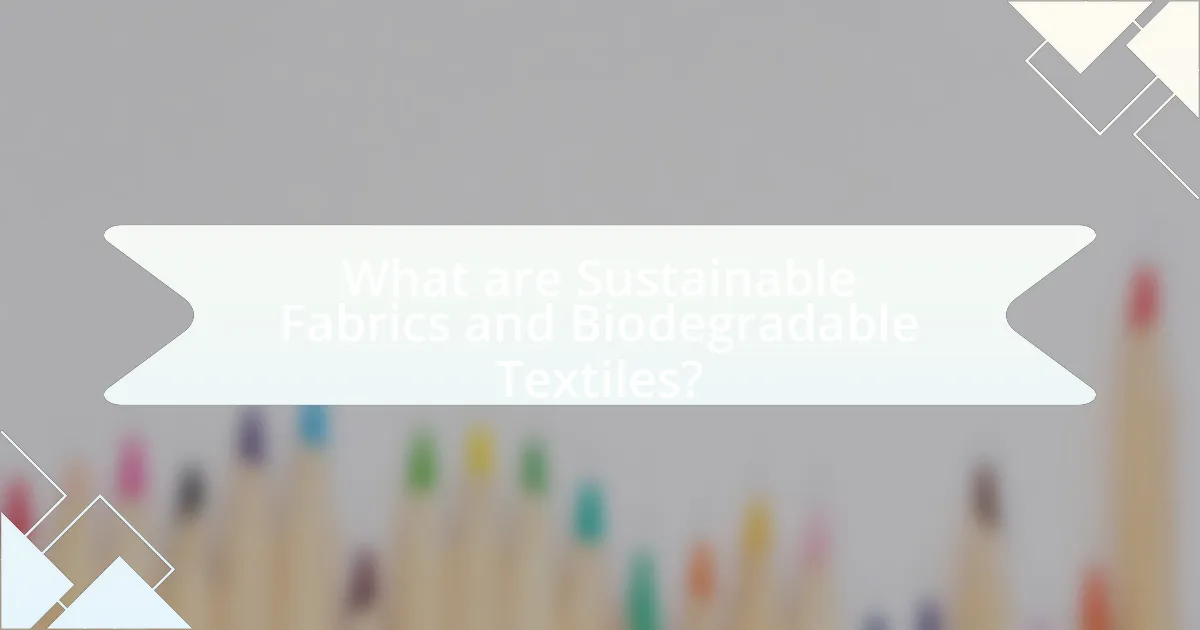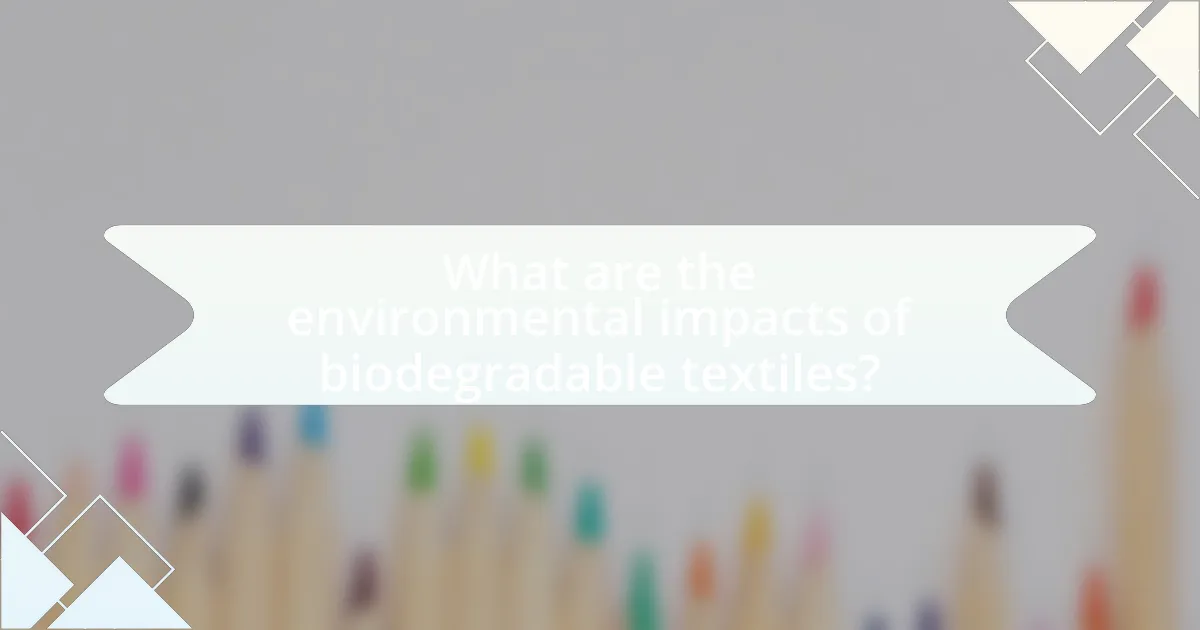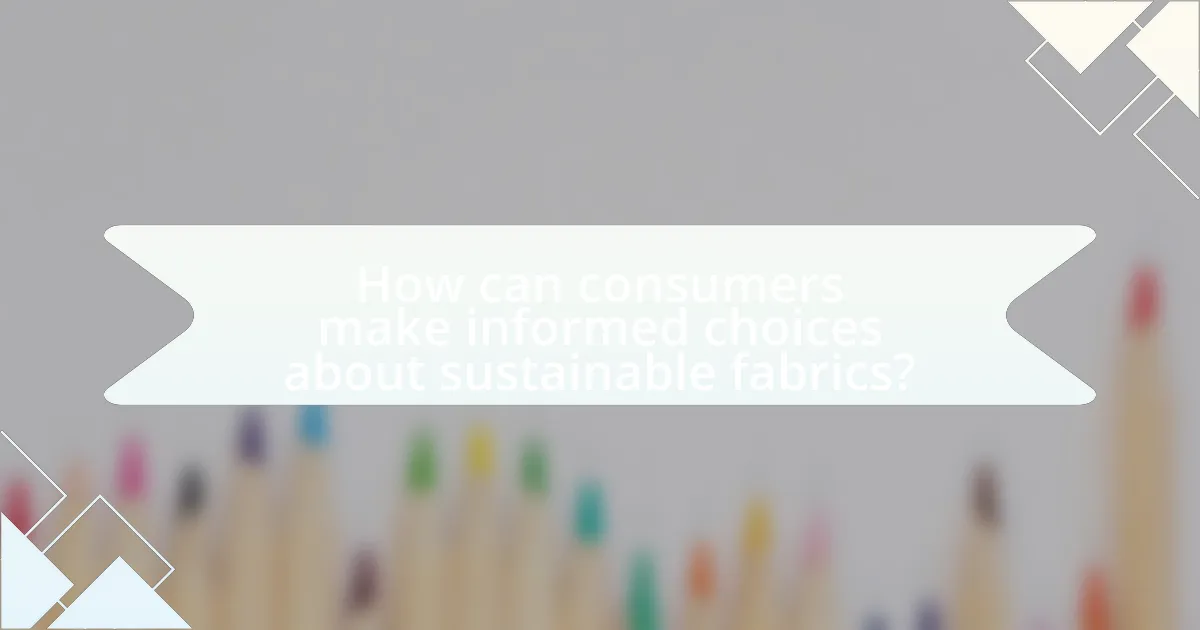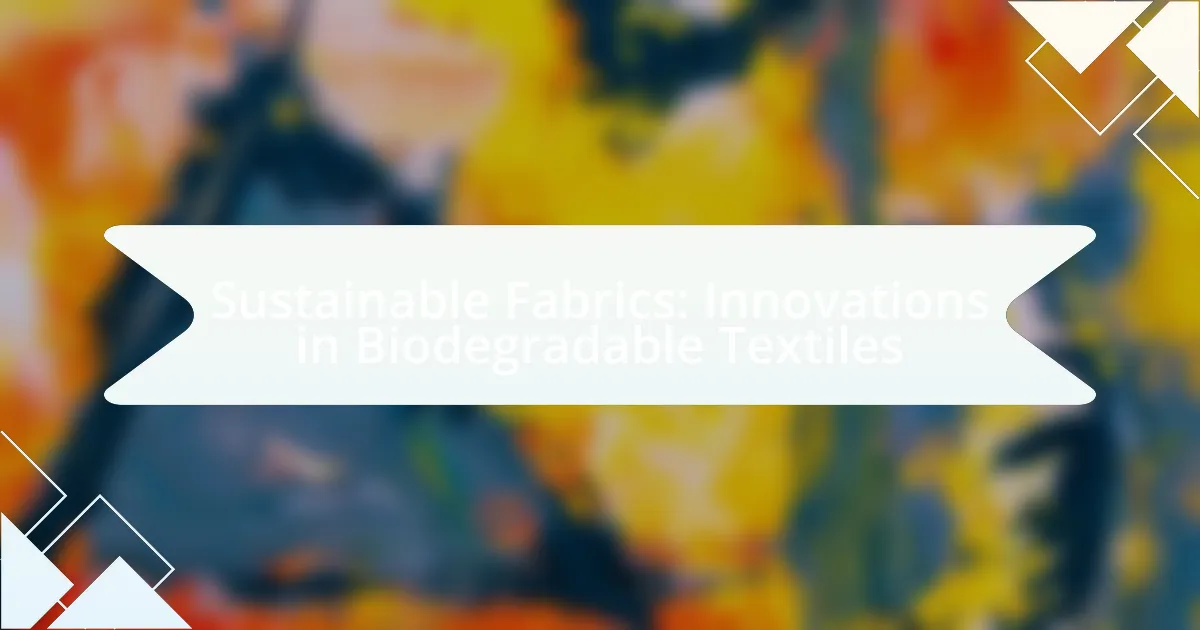Sustainable fabrics are textiles produced with minimal environmental impact, utilizing renewable resources and eco-friendly processes. This article explores the characteristics of sustainable fabrics and biodegradable textiles, highlighting their differences from traditional textiles, commonly used materials, and the importance of biodegradability in reducing landfill waste. It also examines innovations driving the development of biodegradable textiles, the role of natural fibers, and the environmental impacts associated with their production and disposal. Additionally, the article addresses market challenges, consumer awareness, and practical tips for making informed choices about sustainable fabrics, showcasing brands leading in sustainable fabric innovations.

What are Sustainable Fabrics and Biodegradable Textiles?
Sustainable fabrics are textiles produced with minimal environmental impact, utilizing renewable resources and eco-friendly processes. These fabrics often include organic cotton, hemp, and Tencel, which are grown without harmful pesticides and require less water than conventional materials. Biodegradable textiles, on the other hand, are designed to decompose naturally after their useful life, reducing landfill waste. Examples include fabrics made from natural fibers like silk and wool, as well as innovative materials like biodegradable polyester derived from plant sources. The production of these textiles often adheres to sustainable practices, such as reduced energy consumption and lower carbon emissions, contributing to a more sustainable fashion industry.
How do sustainable fabrics differ from traditional textiles?
Sustainable fabrics differ from traditional textiles primarily in their environmental impact and production processes. Sustainable fabrics are made from renewable resources, such as organic cotton or recycled materials, which reduce reliance on fossil fuels and minimize waste. In contrast, traditional textiles often utilize non-renewable resources and chemical-intensive processes that contribute to pollution and resource depletion. For instance, the production of conventional cotton requires significant amounts of pesticides and water, while sustainable alternatives aim to use less water and avoid harmful chemicals, promoting a more eco-friendly lifecycle.
What materials are commonly used in sustainable fabrics?
Sustainable fabrics commonly utilize materials such as organic cotton, hemp, linen, Tencel, and recycled polyester. Organic cotton is grown without synthetic pesticides or fertilizers, reducing environmental impact. Hemp is a fast-growing plant that requires minimal water and no pesticides, making it highly sustainable. Linen, derived from the flax plant, is biodegradable and uses less water than conventional cotton. Tencel, made from sustainably sourced wood pulp, is produced in a closed-loop process that recycles water and solvents. Recycled polyester, made from post-consumer plastic bottles, diverts waste from landfills and reduces reliance on virgin petroleum-based materials. These materials collectively contribute to the sustainability of the textile industry by minimizing environmental harm and promoting resource efficiency.
Why is biodegradability important in textiles?
Biodegradability is important in textiles because it significantly reduces environmental impact by allowing materials to decompose naturally, thus minimizing landfill waste. Traditional textiles, often made from synthetic fibers, can take hundreds of years to break down, contributing to pollution and resource depletion. In contrast, biodegradable textiles, such as those made from organic cotton or hemp, can decompose within months, returning nutrients to the soil and reducing the carbon footprint associated with textile production and disposal. Studies indicate that the fashion industry is responsible for 10% of global carbon emissions, highlighting the need for sustainable alternatives like biodegradable fabrics to mitigate climate change effects.
What innovations are driving the development of biodegradable textiles?
Innovations driving the development of biodegradable textiles include the use of natural fibers, bio-based polymers, and advanced manufacturing techniques. Natural fibers such as organic cotton, hemp, and bamboo are increasingly utilized due to their inherent biodegradability and lower environmental impact compared to synthetic fibers. Bio-based polymers, like polylactic acid (PLA) derived from corn starch, are being developed to replace petroleum-based materials, offering similar performance while being compostable. Additionally, advancements in manufacturing processes, such as enzymatic treatments and 3D knitting, enhance the biodegradability of textiles by reducing the use of harmful chemicals and enabling the creation of more sustainable fabric structures. These innovations collectively contribute to a significant reduction in textile waste and environmental pollution.
How are technological advancements influencing biodegradable fabric production?
Technological advancements are significantly enhancing biodegradable fabric production by improving material properties and production processes. Innovations such as bioengineering and nanotechnology enable the development of fabrics that decompose more efficiently and possess desirable characteristics like durability and moisture resistance. For instance, research has shown that using enzymes in the production process can accelerate biodegradation rates, making fabrics like polylactic acid (PLA) more environmentally friendly. Additionally, advancements in 3D printing technology allow for the creation of complex biodegradable structures that reduce waste during manufacturing. These developments collectively contribute to a more sustainable textile industry by minimizing environmental impact while meeting consumer demands for performance and eco-friendliness.
What role do natural fibers play in sustainable fabric innovations?
Natural fibers are crucial in sustainable fabric innovations as they offer biodegradable alternatives to synthetic materials. These fibers, such as cotton, hemp, and flax, decompose naturally, reducing environmental impact and waste accumulation. Research indicates that natural fibers require less energy and water for production compared to synthetic fibers, making them more sustainable. For instance, a study published in the Journal of Cleaner Production highlights that organic cotton uses 91% less water than conventional cotton. Additionally, natural fibers contribute to lower carbon emissions during their lifecycle, further supporting sustainability in the textile industry.

What are the environmental impacts of biodegradable textiles?
Biodegradable textiles have positive environmental impacts, primarily by reducing landfill waste and minimizing pollution. When these textiles decompose, they break down into natural substances, which can enrich the soil rather than contributing to long-lasting waste. For instance, studies indicate that biodegradable materials can decompose within a few months to a few years, depending on conditions, compared to synthetic textiles that can take hundreds of years to break down. Additionally, the production of biodegradable textiles often involves less harmful chemicals and lower energy consumption, further decreasing their ecological footprint.
How do biodegradable textiles contribute to waste reduction?
Biodegradable textiles contribute to waste reduction by decomposing naturally in the environment, thus minimizing landfill accumulation. Unlike conventional synthetic fabrics, which can take hundreds of years to break down, biodegradable textiles are designed to decompose within a few months to a few years, depending on environmental conditions. This rapid decomposition process significantly reduces the volume of textile waste that persists in landfills, where it contributes to pollution and greenhouse gas emissions. For instance, a study published in the journal “Environmental Science & Technology” found that biodegradable materials can reduce landfill waste by up to 30% compared to traditional textiles.
What is the lifecycle of biodegradable textiles compared to conventional fabrics?
The lifecycle of biodegradable textiles is significantly shorter and more environmentally friendly compared to conventional fabrics. Biodegradable textiles, made from natural fibers or bio-based materials, decompose within a few months to a few years when exposed to the right conditions, such as moisture and microorganisms. In contrast, conventional fabrics, often made from synthetic fibers like polyester or nylon, can take hundreds of years to decompose, contributing to long-term environmental pollution.
Research indicates that biodegradable textiles can reduce landfill waste and lower carbon emissions during their lifecycle. For instance, a study published in the journal “Environmental Science & Technology” found that the production and disposal of synthetic textiles contribute approximately 1.2 billion tons of greenhouse gases annually, while biodegradable options can mitigate this impact significantly.
How do biodegradable textiles affect soil health after disposal?
Biodegradable textiles positively affect soil health after disposal by enhancing soil structure and nutrient content. When these textiles decompose, they release organic matter, which improves soil aeration and water retention. Studies have shown that the breakdown of biodegradable materials can increase microbial activity, leading to a healthier soil ecosystem. For instance, research published in the journal “Environmental Science & Technology” indicates that the incorporation of biodegradable fibers into soil can boost nutrient availability, promoting plant growth and overall soil fertility.
What challenges do biodegradable textiles face in the market?
Biodegradable textiles face significant challenges in the market, primarily related to cost, consumer awareness, and performance. The production of biodegradable materials often incurs higher costs compared to conventional textiles, which can deter manufacturers and retailers from adopting these sustainable options. Additionally, consumer awareness regarding the benefits and availability of biodegradable textiles remains low, limiting market demand. Performance issues, such as durability and maintenance, also pose challenges, as many biodegradable fabrics may not meet the expectations of consumers accustomed to traditional textiles. These factors collectively hinder the widespread adoption of biodegradable textiles in the fashion and textile industry.
Why is consumer awareness important for the adoption of biodegradable textiles?
Consumer awareness is crucial for the adoption of biodegradable textiles because it drives demand for sustainable products. When consumers understand the environmental benefits of biodegradable textiles, such as reduced landfill waste and lower carbon footprints, they are more likely to choose these materials over conventional options. Research indicates that 66% of global consumers are willing to pay more for sustainable brands, highlighting the impact of awareness on purchasing decisions. Increased consumer knowledge leads to greater market pressure on manufacturers to produce biodegradable textiles, ultimately fostering innovation and wider availability in the market.
What are the economic implications of switching to biodegradable textiles?
Switching to biodegradable textiles can lead to significant economic implications, including reduced waste management costs and potential new market opportunities. The transition to biodegradable materials can decrease landfill expenses, as these textiles decompose more quickly than traditional synthetic fabrics, which can take hundreds of years to break down. For instance, the global biodegradable textiles market is projected to grow from $1.5 billion in 2020 to $3.5 billion by 2025, indicating a rising demand that can stimulate job creation in sustainable manufacturing sectors. Additionally, companies adopting biodegradable textiles may benefit from enhanced brand loyalty and consumer preference, as environmentally conscious consumers increasingly favor sustainable products. This shift can lead to increased sales and market share for businesses that invest in biodegradable options.

How can consumers make informed choices about sustainable fabrics?
Consumers can make informed choices about sustainable fabrics by researching the materials’ environmental impact, certifications, and production processes. Understanding the differences between natural fibers, such as organic cotton and hemp, and synthetic alternatives, like recycled polyester, helps consumers assess sustainability. Certifications like Global Organic Textile Standard (GOTS) and OEKO-TEX provide assurance of eco-friendly practices. Additionally, consumers should consider the lifecycle of fabrics, including biodegradability and recyclability, to ensure their choices contribute positively to environmental sustainability.
What should consumers look for when selecting biodegradable textiles?
Consumers should look for certifications and material composition when selecting biodegradable textiles. Certifications such as Global Organic Textile Standard (GOTS) or OEKO-TEX indicate that the textiles meet specific environmental and safety criteria. Additionally, consumers should ensure that the materials used, such as organic cotton, hemp, or Tencel, are derived from renewable resources and designed to decompose naturally, typically within a few months to a few years, depending on environmental conditions. This ensures that the textiles will not contribute to long-term waste in landfills.
How can consumers verify the sustainability claims of textile products?
Consumers can verify the sustainability claims of textile products by checking for certifications from recognized organizations, such as Global Organic Textile Standard (GOTS) or OEKO-TEX. These certifications ensure that the products meet specific environmental and social criteria. For instance, GOTS requires that at least 70% of the fibers are organic and that the manufacturing process adheres to strict environmental standards. Additionally, consumers can research the brand’s transparency regarding its supply chain and sustainability practices, as brands that openly share information about their sourcing and production processes are often more credible.
What are some brands leading the way in sustainable fabric innovations?
Brands leading the way in sustainable fabric innovations include Patagonia, Stella McCartney, and Tencel. Patagonia is recognized for its use of recycled materials and commitment to environmental responsibility, with over 69% of its products made from recycled materials as of 2021. Stella McCartney focuses on cruelty-free and sustainable practices, utilizing organic cotton and innovative materials like Mylo, a leather alternative made from mycelium. Tencel, produced by Lenzing AG, is known for its biodegradable fibers derived from sustainably sourced wood pulp, with a closed-loop production process that minimizes environmental impact. These brands exemplify leadership in the sustainable fabric sector through their innovative approaches and commitment to eco-friendly practices.
What practical tips can consumers follow to support sustainable fabric use?
Consumers can support sustainable fabric use by choosing textiles made from organic or recycled materials. Organic fabrics, such as cotton or linen, are produced without harmful pesticides and fertilizers, reducing environmental impact. Recycled fabrics, like those made from post-consumer plastic bottles, help divert waste from landfills and decrease the demand for virgin materials. Additionally, consumers should prioritize brands that practice ethical manufacturing and transparency in their supply chains, as this promotes responsible production methods. Research indicates that the fashion industry is responsible for 10% of global carbon emissions, highlighting the importance of sustainable choices in fabric selection.

Leave a Reply